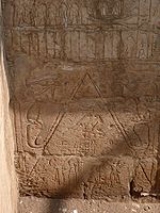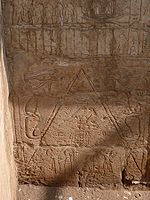
Shoshenq III
Encyclopedia
King Usermaatre Setepenre or Usimare Setepenamun Shoshenq III ruled Egypt's
22nd Dynasty
for 39 years according to contemporary historical records. Two Apis
Bulls were buried in the fourth and 28th years of his reign and he celebrated his Heb Sed Jubilee in his regnal year
30. Little is known of the precise basis for his successful claim to the throne since he was not a son of Osorkon II
and Shoshenq's parentage and family ties are unknown.
From Shoshenq III's eighth regnal year, his reign was marked by the loss of Egypt's political unity, with the appearance of Pedubast I
at Thebes
. Henceforth, the kings of the 22nd Dynasty only controlled Lower Egypt
. The Theban High Priest Osorkon B (the future Osorkon III
) did date his activities at Thebes and (Upper Egypt
) to Shoshenq III's reign but this was solely for administrative reasons since Osorkon did not declare himself king after the death of his father, Takelot II
. On the basis of Osorkon B's well known Chronicle, most Egyptologists today accept that Takelot II's 25th regnal year is equivalent to Shoshenq III's 22nd year.
at Memphis, and Tjesbastperu, Osorkon II
's daughter. He had at least 4 sons and 1 daughter: Ankhesen-Shoshenq, Bakennefi A, Pashedbast B, Pimay
the 'Great Chief of the Ma
', and Takelot C, a Generalissimo. A certain Padehebenbast may also have been another son of Shoshenq III but this is not certain. They all appear to have predeceased their father through his nearly four decade long rule. Shoshenq III's third son, Pimay
('The Lion' in Egyptian), was once thought to be identical with king Pami
('The Cat' in Egyptian), but it is now believed that they are two different individuals, due to the separate orthography and meaning of their names. Instead, it was an unrelated individual named Shoshenq IV who ultimately succeeded Shoshenq III.
Shoshenq III was buried in the looted Royal Tomb NRT V at Tanis
.

Ancient Egypt
Ancient Egypt was an ancient civilization of Northeastern Africa, concentrated along the lower reaches of the Nile River in what is now the modern country of Egypt. Egyptian civilization coalesced around 3150 BC with the political unification of Upper and Lower Egypt under the first pharaoh...
22nd Dynasty
Twenty-second dynasty of Egypt
The Twenty-First, Twenty-Second, Twenty-Third, Twenty-Fourth and Twenty-Fifth Dynasties of ancient Egypt are often combined under the group title, Third Intermediate Period.-Rulers:...
for 39 years according to contemporary historical records. Two Apis
Apis (Egyptian mythology)
In Egyptian mythology, Apis or Hapis , was a bull-deity worshipped in the Memphis region.According to Manetho, his worship was instituted by Kaiechos of the Second Dynasty. Hape is named on very early monuments, but little is known of the divine animal before the New Kingdom...
Bulls were buried in the fourth and 28th years of his reign and he celebrated his Heb Sed Jubilee in his regnal year
Regnal year
A regnal year is a year of the reign of a sovereign, from the Latin regnum meaning kingdom, rule.The oldest dating systems were in regnal years, and considered the date as an ordinal, not a cardinal number. For example, a monarch could have a first year of rule, a second year of rule, a third, and...
30. Little is known of the precise basis for his successful claim to the throne since he was not a son of Osorkon II
Osorkon II
Usermaatre Setepenamun Osorkon II was a pharaoh of the Twenty-second Dynasty of Ancient Egypt and the son of Takelot I and Queen Kapes. He ruled Egypt around 872 BC to 837 BC from Tanis, the capital of this Dynasty. After succeeding his father, he was faced with the competing rule of his cousin,...
and Shoshenq's parentage and family ties are unknown.
From Shoshenq III's eighth regnal year, his reign was marked by the loss of Egypt's political unity, with the appearance of Pedubast I
Pedubast I
Pedubastis I or Pedubast I was an Upper Egyptian Pharaoh of Ancient Egypt during the 9th century BC. Based on lunar dates which are known to belong to the reign of his rival in Upper Egypt Takelot II and the fact that Pedubast I first appeared as a local king at Thebes around Year 11 of Takelot...
at Thebes
Thebes, Egypt
Thebes is the Greek name for a city in Ancient Egypt located about 800 km south of the Mediterranean, on the east bank of the river Nile within the modern city of Luxor. The Theban Necropolis is situated nearby on the west bank of the Nile.-History:...
. Henceforth, the kings of the 22nd Dynasty only controlled Lower Egypt
Upper and Lower Egypt
Ancient Egypt was divided into two regions, namely Upper Egypt and Lower Egypt. To the north was Lower Egypt where the Nile stretched out with its several branches to form the Nile Delta. To the south was Upper Egypt, stretching to Syene. The two kingdoms of Upper and Lower Egypt were united c....
. The Theban High Priest Osorkon B (the future Osorkon III
Osorkon III
Usermaatre Setepenamun Osorkon III Si-Ese was Pharaoh of Egypt in the 8th Century BC. He is the same person as the Crown Prince and High Priest of Amun Osorkon B, son of Takelot II by his Great Royal Wife Karomama II. Prince Osorkon B is best attested by his Chronicle—which consists of a series of...
) did date his activities at Thebes and (Upper Egypt
Upper and Lower Egypt
Ancient Egypt was divided into two regions, namely Upper Egypt and Lower Egypt. To the north was Lower Egypt where the Nile stretched out with its several branches to form the Nile Delta. To the south was Upper Egypt, stretching to Syene. The two kingdoms of Upper and Lower Egypt were united c....
) to Shoshenq III's reign but this was solely for administrative reasons since Osorkon did not declare himself king after the death of his father, Takelot II
Takelot II
Hedjkheperre Setepenre Takelot II Si-Ese was a pharaoh of the Twenty-Third Dynasty of Ancient Egypt in Middle and Upper Egypt. He has been identified as the High Priest of Amun Takelot F, son of the High Priest of Amun Nimlot C at Thebes and, thus, the son of Nimlot C and grandson of king Osorkon...
. On the basis of Osorkon B's well known Chronicle, most Egyptologists today accept that Takelot II's 25th regnal year is equivalent to Shoshenq III's 22nd year.
Family
Shoshenq III married Djed-Bast-Es-Ankh, the daughter of Takelot, a High Priest of PtahPtah
In Ancient Egyptian Religion, Ptah was the deification of the primordial mound in the Ennead cosmogony, which was more literally referred to as Ta-tenen , meaning risen land, or as Tanen, meaning submerged land, though Tatenen was a god in his...
at Memphis, and Tjesbastperu, Osorkon II
Osorkon II
Usermaatre Setepenamun Osorkon II was a pharaoh of the Twenty-second Dynasty of Ancient Egypt and the son of Takelot I and Queen Kapes. He ruled Egypt around 872 BC to 837 BC from Tanis, the capital of this Dynasty. After succeeding his father, he was faced with the competing rule of his cousin,...
's daughter. He had at least 4 sons and 1 daughter: Ankhesen-Shoshenq, Bakennefi A, Pashedbast B, Pimay
Pimay
Pimay was a son of king Shoshenq III who served as a 'Great Chief of the Ma' during his father's reign.While it was traditionally assumed that Pimay succeeded his father, newer archaeological evidence uncovered by Aidan Dodson in 1993 established that a new Tanite dynasty 22 king named Shoshenq IV...
the 'Great Chief of the Ma
Meshwesh
The Meshwesh were an ancient Libyan tribe from beyond Cyrenaica where the Libu and Tehenu lived according to Egyptian references and who were probably of Central Berber ethnicity. Herodotus placed them in Tunisia and said of them to be sedentary farmers living in settled permanent houses as the...
', and Takelot C, a Generalissimo. A certain Padehebenbast may also have been another son of Shoshenq III but this is not certain. They all appear to have predeceased their father through his nearly four decade long rule. Shoshenq III's third son, Pimay
Pimay
Pimay was a son of king Shoshenq III who served as a 'Great Chief of the Ma' during his father's reign.While it was traditionally assumed that Pimay succeeded his father, newer archaeological evidence uncovered by Aidan Dodson in 1993 established that a new Tanite dynasty 22 king named Shoshenq IV...
('The Lion' in Egyptian), was once thought to be identical with king Pami
Pami
Usermaatre Setepenre Pami was an Egyptian Pharaoh who ruled Egypt for 7 years. He was a member of the Twenty-second dynasty of Egypt of Meshwesh Libyans who had been living in the country since the Twentieth dynasty of Egypt when their ancestors infiltrated into the Egyptian Delta from Libya...
('The Cat' in Egyptian), but it is now believed that they are two different individuals, due to the separate orthography and meaning of their names. Instead, it was an unrelated individual named Shoshenq IV who ultimately succeeded Shoshenq III.
Shoshenq III was buried in the looted Royal Tomb NRT V at Tanis
Tanis, Egypt
Tanis , the Greek name of ancient Djanet , is a city in the north-eastern Nile delta of Egypt. It is located on the Tanitic branch of the Nile which has long since silted up.-History:...
.


